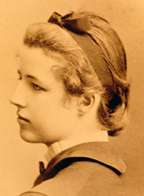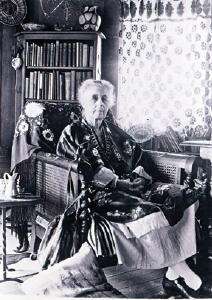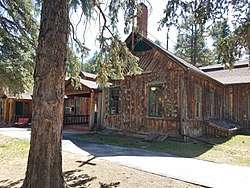Josepha Williams Douglas
Josepha Williams Douglas (1860–1938), also commonly known as Josepha Williams, was a physician and co-operator of the Marquette-Williams Sanitarium in Denver, Colorado. She was one of the first female doctors in the state. She, as well as her mother Mary Neosho Williams, purchased a number of tracts of land in the Evergreen, Colorado area, at least some of which were ultimately donated for the Evergreen Conference District. Douglas was the daughter of Civil War General Thomas Williams and wife of Canon Charles Winfred Douglas, a plainsong musical expert and Episcopalian priest.

Early life

Douglas was born Mary Josepha Williams in Virginia,[3][4] the daughter of Civil War General Thomas Williams and Mary Neosho Bailey Williams.[5] Her parents were a wealthy family from Detroit, Michigan.[6] Her brothers were John R. Williams and Gershom Mott Williams,[7] the first bishop of the Episcopal Diocese of Marquette who later published General Williams' personal papers.[8]
Douglas was a member of the Daughters of the American Revolution; she was the great-granddaughter of Captain Gershom Mott who was a commander at New Windsor and Fort Constitution during the Revolutionary War.[4]
Education
Douglas, under the name Josepha Williams, graduated in 1889 from the Gross Medical College,[9] which was rolled into the University of Colorado Denver School of Medicine in 1911.[10][11]
Career
After obtaining her M.D., Douglas practiced medicine in Denver beginning in 1889.[12] She was among the state's first female physicians.[13]
Douglas and Dr. Madeline Marquette founded the Marquette-Williams Sanitarium, a medical and surgical center, at 1542 Pearl Street in Denver in 1891. In 1892 they established a nursing school in conjunction with the sanitarium. Douglas was superintendent of the sanitarium.[14][15]
Douglas became a member of the Colorado Medical Society in 1894.[16]
Evergreen

Douglas purchased several hundred acres of land in Evergreen in 1893 near the cabin of her maternal uncle, Dr. Thomas Bailey.[17] She had a one-room cabin with a "massive" stone fireplace built for her by John Spence from a partially finished barn. After the cabin was constructed, Douglas and her mother commissioned Spence to build a large addition that included a two-story tower with a servant's kitchen, library, second-story bedroom, and several porches.[17] After Mary Williams death in 1914, it was further expanded upon by Douglas and her husband.[17] It ultimately grew through Spence's efforts to a 17-room lodge with vaulted ceilings, two octagonal towers and a private chapel used by Canon Charles Winfield Douglas.[18][lower-alpha 1]
The summer retreat called Camp Neosho[19] also had a number of tents were installed with wood-burning stoves, platform floors made of wood, and double canvas walls by Mary Williams. Visitors included Williams' siblings and their families.[17] The lodge is now the Hiwan Homestead Museum.[18]
Williams began holding Episcopal church services in tents in 1893. She purchased Stewart Hotel, which was transformed into St. Mark's in the Wilderness church, later Mission of the Transfiguration.[20] Douglas also purchased land around the Evergreen area and received the former Stewart Hotel through her mother's will.[21] Land and buildings were donated for the creation of the Evergreen Conference District.[20]
Personal life
The Mission of the Holy Redeemer was established in 1893 in a vacated church building at Lawrence and 10th Street, with the authorization of Bishop John F. Spalding of Cathedral of St. John in the Wilderness. The new congregation included African-American Episcopalians and White Anglo-Catholics. Douglas, her mother and church clergy and leaders met with African-American leaders from Kansas City, Kansas and people who moved to Denver from Memphis, Tennessee. In January 1894, its first church services were conducted.[22]
Douglas sailed for Europe in January 1896 for a four-month vacation in Genoa, Italy with Dr. Marquette Baker.[23]
Dr. Douglas married Canon Charles Winfred Douglas at the Cathedral of St. John in the Wilderness on July 22, 1896.[19] In 1894,[17] Canon Charles Winfred Douglas had moved to Evergreen from New York to recuperate from pneumonia and tuberculosis[19][18][24] and subsequently was under the care of Dr. Douglas.[3]
The couple moved to Evergreen after they had married.[24] Canon Douglas began attending Evergreen's summer retreats and music camps in 1897. He led musical events, which increased the popularity of the center. Douglas was priest of the retreat's church, the Mission of the Transfiguration, for more than 40 years.[20][24]
Their son, Frederic Huntington Douglas[3][25] was born in Evergreen in 1897.[26] He was later a Native Arts curator at the Denver Art Museum.[25]
The family moved to New York in 1902 while Canon Douglas pursued in musical and religious career, having the previous year studied plainsong and Gregorian chants in England, France, Germany, and Scotland. He became ill again in 1903 and stayed in a number of eastern convalescent centers before traveling to New Mexico for a six-month stay.[26] In 1918, he edited the New Hymnal of the Episcopal church and in 1940 helped create The Hymnal of 1940.[19]
Dr. Douglas died on March 9, 1938[3][19] in Evergreen after a long illness.[24] Canon Douglas married Anne Woodward in 1940, with whom he worked with on The Hymnal of 1940, and died on January 28, 1944.[24]
See also
- Denver public health advocates
- Dr. Frederick J. Bancroft, 19th century Colorado public health advocate
- Frances Wisebart Jacobs, advocate for tuberculosis healthcare and founder of Denver's Jewish Hospital
- Williams family
- John R. Williams, first mayor of Denver and her grandfather
- Thomas Williams (pioneer), early settler to Detroit and her great-grandfather
Notes
- Noel states that Mary Neosho Williams began construction of the lodge in 1887,[18] but Shellenbarger states that Josepha purchased the property in 1893 and that the construction of the lodge began with a one-room cabin that she had built by John Spence.[17] Noel also states that Dr. Douglas received the lodge upon her mother's death.[18]
References
- "Evergreen Conference District Nomination Form" (PDF). National Register of Historic Places. National Park Service. Retrieved October 6, 2016.
- "Jefferson County Neighborhoods: The Hiwans of Evergreen". City and Mountain Views. Retrieved October 6, 2016.
- The Hymnal 1940 Companion. Church Pension Fund. 1956. p. 420.
- Daughters of the American Revolution (1897). Lineage Book - National Society of the Daughters of the American Revolution. Daughters of the American Revolution. p. 46.
- Melanie Shellenbarger (1 November 2012). High Country Summers: The Early Second Homes of Colorado, 1880Ð1940. University of Arizona Press. p. 238. ISBN 978-0-8165-2958-2.
- Lesley Poling-Kempes (September 17, 2015). Ladies of the Canyons: A League of Extraordinary Women and Their Adventures in the American Southwest. University of Arizona Press. p. 72. ISBN 978-0-8165-3231-5.
- Michigan Supreme Court; Harry Burns Hutchins; Randolph Manning (1879). Michigan Reports: Cases Decided in the Supreme Court of Michigan. Phelphs & Stevens, printers. p. 558.
- "Michigan's Tuition Charges Were Small in 1827". The Michigan Alumnus. UM Libraries. 1935. p. 521. UOM:39015006954393.
Biographical information about John R. Williams and other family members.
- "Graduates of Colorado's Medical Schools, 1881-1899". Colorado's Healthcare Heritage. Retrieved October 6, 2016.
- "Let your Light Shine". University of Colorado. Archived from the original on 2005-04-23. Retrieved 2010-01-30.
- "University History". University of Colorado Denver. Retrieved December 18, 2015.
- Tom Sherlock (15 April 2013). Colorado's Healthcare Heritage: A Chronology of the Nineteenth and Twentieth Centuries Volume One — 1800-1899. iUniverse. p. 339. ISBN 978-1-4759-8026-4.
- Victor J. Danilov (June 2000). Colorado museums and historic sites. University Press of Colorado. p. 202. ISBN 978-0-87081-572-0.
- Tom Sherlock (15 April 2013). Colorado's Healthcare Heritage: A Chronology of the Nineteenth and Twentieth Centuries Volume One — 1800-1899. iUniverse. p. 363. ISBN 978-1-4759-8026-4.
- Denver Medical Times: Utah Medical Journal. Nevada Medicine. Denver, Colorado. 1892. p. 566.
- Transactions of the Colorado State Medical Society. The Society. 1894. pp. 35, 42.
- Melanie Shellenbarger (November 1, 2012). High Country Summers: The Early Second Homes of Colorado, 1880–1940. University of Arizona Press. p. 156. ISBN 978-0-8165-9933-2.
- Thomas J. Noel (28 February 2007). Guide to Colorado Historic Places: Sites Supported by the Colorado Historical Society's State Historical Fund. Big Earth Publishing. p. 178. ISBN 978-1-56579-493-1.
- Tom Sherlock (15 April 2013). Colorado's Healthcare Heritage: A Chronology of the Nineteenth and Twentieth Centuries Volume One — 1800-1899. iUniverse. p. 438. ISBN 978-1-4759-8026-4.
- "Evergreen Conference District Nomination Form" (PDF). National Register of Historic Places. National Park Service. Retrieved October 6, 2016.
- Melanie Shellenbarger (1 November 2012). High Country Summers: The Early Second Homes of Colorado, 1880Ð1940. University of Arizona Press. p. 238. ISBN 978-0-8165-2958-2.
- Tom Sherlock (15 April 2013). Colorado's Healthcare Heritage: A Chronology of the Nineteenth and Twentieth Centuries Volume One — 1800-1899. iUniverse. p. 382. ISBN 978-1-4759-8026-4.
- The Colorado Medical Journal. Colorado Medical Journal Publishing Company. 1896. p. 58.
- Clifford P. Morehouse, ed. (May 28, 1944). The Living Church (Episcopal Church). Milwaukee, Wisconsin: Morehouse-Gorham Company. p. 30.
- "Hiwan History Museum". Evergreen Chamer of Commerce. Retrieved October 6, 2016.
- Lesley Poling-Kempes (September 17, 2015). Ladies of the Canyons: A League of Extraordinary Women and Their Adventures in the American Southwest. University of Arizona Press. p. 73. ISBN 978-0-8165-3231-5.
Further reading
- The Church Eclectic: A Monthly Magazine of Church Literature and Church Work; with Notes and News Summaries. Milwaukee, Minnesota: The Young Churchman Company. July 1897. p. 381.
A description of her wedding ceremony.
- Jack Maher and Devan Crean (April 11, 2016). "Hiwan Homestead Museum brings the past alive for students". The Denver Post.
Story about Williams-Douglas family life at the lodge
- Patricia Chambers Walker; Thomas Graham (2000). "Evergreen: Hiwan Homestead Museum". Directory of Historic House Museums in the United States. Rowman & Littlefield. p. 39. ISBN 978-0-7425-0344-1.